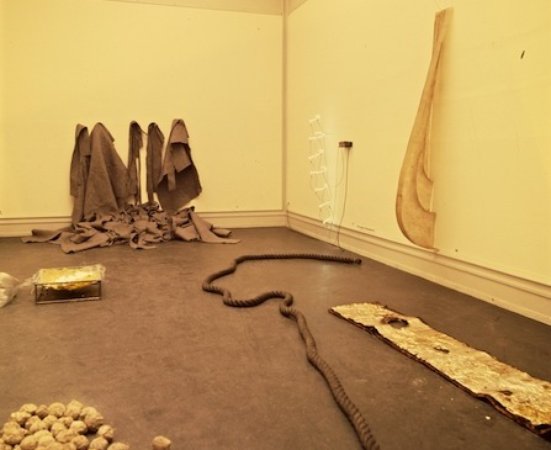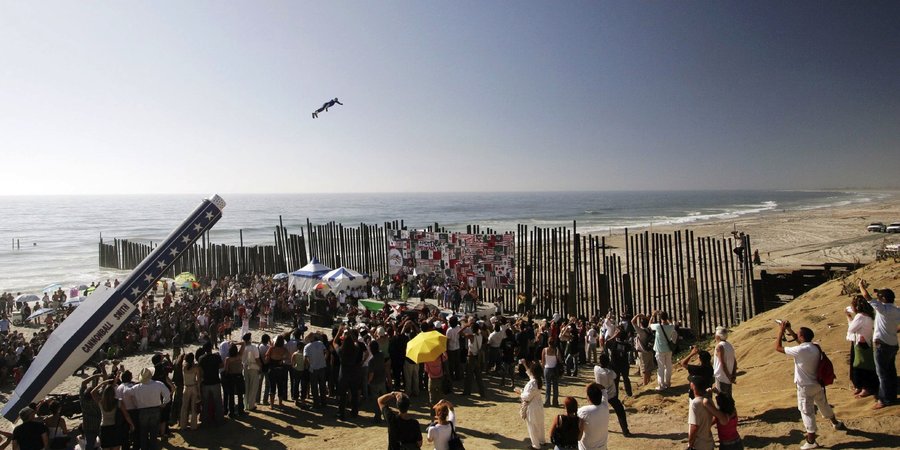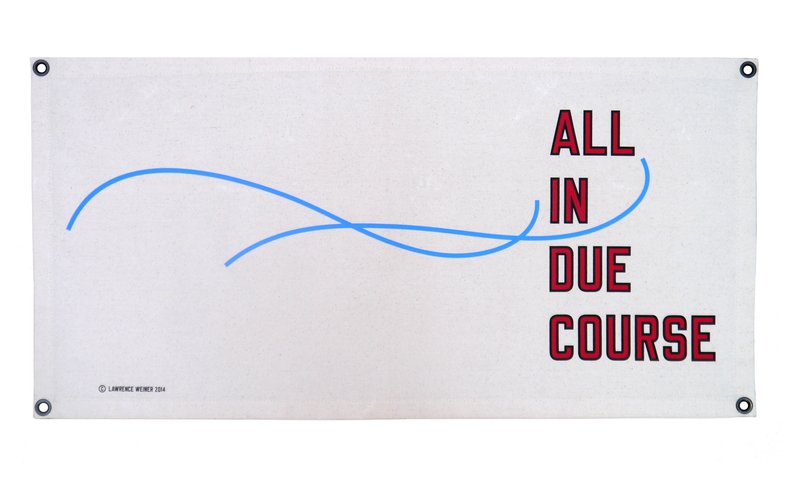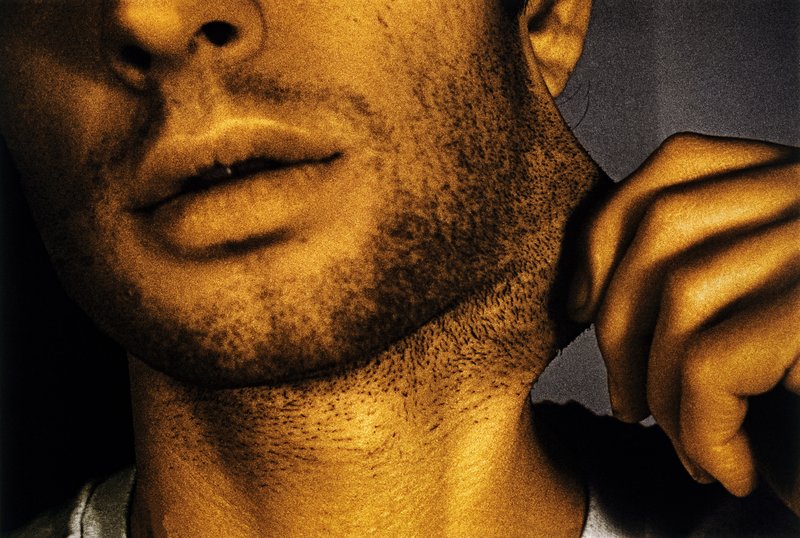If the title of Jens Hoffmann's latest exhibition at the Jewish Museum,"Other Primary Structures," rings a bell, it's because it's a revisiting of one of the most important American art exhibitions of the 20th century: "Primary Structures: Younger American and British Sculptors," the 1966 exhibition organized at the same museum by the pathbreaking curator Kynaston McShine that changed the aesthetic course of American art. But "Other Primary Structures" is not simply a re-staging of McShine's original show; instead, through life-sized reproductions of installation images, timelines, text, a scale model of the Jewish Museum's original building, and a catalogue that cleverly duplicates the design and format of that from the 1966 show, it's an investigation into the nature of the contemporary art exhibition as a cultural event that also seeks to correct the Western-male-centric scope of the original exhibition by including works by artists from outside of the United States and Europe.
It so happens that "Other Primary Structures" is part of a greater conversation brewing about the emerging field of exhibition history. Since at least the 1990s, curating has come to embody a whole range of activities that go beyond simply conserving and interpreting artworks. With recent projects like curator Germano Celant's recent show "When Attitudes Become Form: Bern 1969/Venice 2013" at Venice's Fondazione Prada—a dramatic re-staging of the 1969 exhibition organized by Harald Szeemann that introduced conceptual art to Europe—there's suddenly widespread interest in examining the curatorial history of certain exhibitions that are considered major milestones in contemporary art's development.
Hoffmann is positioning himself to be a major player in this emerging field of the exhibition-as-exhibition-history: his most recent book Show Time: The 50 Most Influential Exhibitions of Contemporary Art, published by D.A.P., is a useful compendium of the most important museum exhibitions, biennials, and experimental exhibition projects from the late 1980s through today, offering a thorough look at art exhibitions from the past 30 years that have dramatically altered the way artists, curators, and art patrons experience the contemporary exhibition. It's a must-read for the art history nerds out there, and a fascinating introduction to a nascent field for everyone else.
Following Hoffmann's lead, we were inspired to make our own list of the most exciting, influential, and forward-thinking exhibitions in the relatively brief history of contemporary art. Perhaps some of them are ready for the "redo" treatment as well.
"PRIMARY STRUCTURES: YOUNGER AMERICAN AND BRITISH SCULPTORS"
April 27 – June 12, 1966
The Jewish Museum, New York
Curator: Kynaston McShine
"Primary Structures" was the exhibition that introduced Minimalism to American audiences before it was called Minimalism. Featuring the work of seminal American and British artists like Tony Smith, Gerald Laing, Carl Andre, Donald Judd, Robert Morris, and Sol LeWitt, the exhibition included a bounty of large-scale geometric sculptural abstraction. The artist Mark di Suvero called the exhibition, which was both a critical and a media success, "the key show of the 1960s." It popularized the idea of the artist as designer rather than craftsmen, and introduced an entirely new visual lexicon to Western art history. (As Jens Hoffmann's 2014 reboot points out, however, the artists included in the show were all white men. It was 1966. And Kynaston McShine, it bears pointing out, is African-American.)
"LIVE IN YOUR HEAD: WHEN ATTITUDES BECOME FORMS (WORKS – CONCEPTS – PROCESSES – SITUATIONS – INFORMATION)"

March 22 – April 27, 1969
Kunsthalle Bern; traveled to the London ICA
Curator: Harald Szeeman
Perhaps the most well-known and influential exhibition in the history of contemporary art, "When Attitudes Become Form" featured a coterie of artists who were young tyros in 1969 but are now verified icons of 20th-century art: Joseph Beuys, Michael Heizer, Bruce Nauman, Eva Hesse, Richard Serra, Lawrence Weiner, and Barry Flanagan, to name a few. Szeeman's aim was to explore the aesthetic mood of his artistic generation by placing artworks in constellation-like relationships with one another, allowing the tensions between the pieces to define the exhibition space, engaging with and displaying the process of production of the artwork as much as its final results. The included works were all exemplary of post-minimalist strategies, growing out of conceptual practices like Italian Arte Povera, Process Art, and Land Art.
"INFORMATION"
July 2 – September 20, 1970
Museum of Modern Art, New York
Curator: Kynaston McShine
"Information" was a critical survey, and perhaps the first in America, of conceptual art. McShine, then associate curator in MoMA's painting and sculpture department, framed "Information" as an "international report" on the globalizing and democratizing power of new technologies (which, at the time, meant photography, television, film, satellites, and jet travel) that gave artists new avenues for making. Many of the works in the show (by artists like Vito Acconci, Daniel Buren, Art & Language, Jan Dibbets, Ed Ruscha, Robert Smithson, Jeff Wall, and Dennis Oppenheim) required audience participation or activation, the most notorious example being Hans Haacke's MoMA Poll, wherein museum visitors were surveyed about then-governor Nelson Rockefeller's attitude towards President Nixon's policies in Indochina. Rockefeller was on the museum's board; Haacke got away with it by leaving the specific question that the poll would ask out of his initial proposal to the museum. (It might be the most famous example of so-called "institutional critique.") For its political engagement, participatory engagement with its audience, and support of media-based work, "Information" was a pioneering project.
"MAGICIENS DE LA TERRE"
May 18 – August 14, 1989
Centre Georges Pompidou and La Grande Halle, Parc de la Villette, Paris, France
Curator: Jean-Hubert Martin
Jean-Hubert Martin's exhibition purported to counteract the colonial ethnocentricity of contemporary art by including an equal number of artworks from Africa, Asia, Latin America, and Australia as from the U.S. and Europe in a corrective survey of global artworks. Although the show was intended as a corrective response to previous exhibitions at MoMA and the Paris Biennial, "Magiciens de la Terre" was met with much criticism—not to mention the fact that Martin's exhibition was not without its own presentational problems—there's no question that the discussions it sparked permanently changed the course of international curating practices. Alongside globally-recognized Western artists like Alighiero Boetti, Louise Bourgeois, Daniel Spoerri, Mario Merz, and Rebecca Horn, the exhibition featured work by lesser-known artists from "marginal" countries like Kane Kwei, Mike Chukwukelu, and Chéri Samba. The fact that these artists are now as well known as many of their Western counterparts speaks to the fact that the art world is certainly more globalized now than it was in 1989. But there's no question that there is still much work to do.
"inSITE"
1992, 1994, 1997, 2000–1, and 2005
Various sites in Tijuana, Mexico and San Diego, California
Curators: Committee; Jessica Bradley, Olivier Debroise, Ivo Mesquita, Sally Yard
Originally founded to address a perceived lack of cultural institutions in San Diego, with its second iteration in 1994, "inSITE" expanded to locations spanning the area immediately around the U.S.-Mexico border with artists including Gary Simmons, Lorna Simpson, and Nari Ward, among many others, initiating projects in both Tijuana and San Diego. The most impressive facet of the event was the major collaborative efforts required to pull it together—not only between curators and artists, but also between institutions and communities on both sides of the border. Nowadays we take for granted that large-scale semi-annual exhibitions (like the countless Biennials of today) have an international scope, but in basing its format entirely on a specific site of such political and social contest—and in facilitating an open cultural exchange across a delimited political border—the organizers of "inSITE" opened up fresh possibilities for political engagement and set a new precedent in contemporary art's creation of hybrid spaces.
The original "inSITE" was so favorably received by both the art world and the local communities on both sides of the border that it was repeated several times, though not at regular intervals. The exhibition also brought artists from all over the world to the border region, with a major focus on performance work, including One Flew Over the Void (Balla Perdida) (2005), in which the Venezuelan artist Javier Téllez recruited patients of Tijuana's CESAM mental institution to wear animal masks and carry handmade signs in a carnivalesque event that culminated in a human cannonball being launched over the border fence. "inSITE" showed the potential for the contemporary exhibition to efficaciously and sincerely engage with political issues on an international scale.
"CITIES ON THE MOVE: CONTEMPORARY ASIAN ART ON THE TURN OF THE 21st CENTURY"
November 26, 1997–January 18, 1998
Secession, Vienna, Austria; travelled to New York, London, Humbelbæk (Denmark), and Helsinki.
Curators: Hou Hanru and Hans Ulrich Obrist
"Cities on the Move" was a novel and boldly cacophonous portrait of the contemporary Asian metropolis, focused on contemporary art and architecture from East and South Asia. By centering on the conflicted histories of modernization in cities like Bangkok, Tokyo, and Hong Kong, the exhibition was also many Westerner's first exposure to 70 artists and architects who were well known in Asia but had never before been exhibited in Europe. The works on display spanned from painting to architectural projects, installation, sculpture, video, and performance, with projects like a pair of Tuk Tuk taxis by Rirkrit Tiravanija and Navin Rawanchaikul. Other participating artists included Cai Guo Qiang, Chen Zhen, Itusko Hasegawa, Toyo Ito, Greg Lynn, Mariko Mori, Takashi Murakami, Soo-Ja Kim, and Sarah Sze.
"DO IT"
1994–ongoing
Various locations and formats
Curator: Hans Ulrich Obrist
You may have seen the latest iteration of "do it" when it was revived last year in a pop-up installation at the Socrates Sculpture Park in Long Island City, Queens. Initiated in 1994 by curator Hans Ulrich Obrist as a forum for challenging the idea of the exhibition as a singular event limited to specific spaces with a limited timeframe, "do it" consists of a set of artist-produced instructions that can be carried out by anyone, any time; the exhibition's "works" consist of the instructions themselves, as well as their realization as an event or product. "do it" started in 1994, and since then has been revisited in museum installations across Europe and the U.S. and in multiple publications. do it: The Compendium, published last year by D.A.P. and Independent Curators International, compiles all of the instructions produced so far by participating artists, including written contributions by Yoko Ono, Damien Ortega, Pipilotti Rist, Dan Graham, Marina Abramovic, Liam Gillick, Douglas Gordon, and Rosemarie Trockel. The ongoing show exemplifies the process-based, diffuse, collaborative, and decentralized nature of art of the 20th century.
"TRAFFIC"
January 26 – March 24, 1996
CAPC Musée d'Art Contemporain, Bordeaux, France
Curator: Nicolas Bourriaud
It wasn't until after this exhibition opened that its curator, Nicolas Bourriaud, published the book Relational Aesthetics, which went on to become one of the most influential texts of late-20th century art, but "Traffic" sowed the seeds for Bourriaud's treatise. The term "relational aesthetics" was actually used for the first time in the exhibition's catalogue, describing work that is based on a social interaction or experiences between participants; the concept has since become part and parcel of contemporary art discourse. What visitors to the exhibition at Bordeaux's CAPC (housed in a massive warehouse building that had been converted into gallery spaces) encountered was, among other things, Dominique Gonzalez-Foerster's "seance room" where visitors could draw floor plans of their childhood homes; photographs by Jason Rhoades of a brand-new saloon car purchased with money procured from the CAPC as an artwork production cost; and dirty dishes left over from meals shared with friends and colleagues during preparations for the show by Rirkrit Tiravanija—the kind of work that is still considered radically avant-garde, which just goes to show that art history has not yet fully grappled with the show's legacy.
"SENSATION: YOUNG BRITISH ARTISTS FROM THE SAATCHI COLLECTION"
September 18 – December 28, 1997
Royal Academy of Arts, London UK, and touring
Curators: Norman Rosenthal and Charles Saatchi
Charles Saatchi's massive, scandalous exhibition probably had the biggest impact on the art market of any exhibition in the entire history of contemporary art. It was here that Chris Ofili's The Holy Virgin Mary set off a virtual war between the Catholic Church and the art world, imbricating New York's judicial system in the process. (Ofili's painting of the Holy Virgin Mary includes balls of elephant dung and cutouts from pornographic magazines.) Such shock tactics and dark humor abounded; reading the works' titles alone gives one the general idea: included here were Ron Mueck's Dead Dad (1996–97) and Jake and Dinos Chapman's Tragic Anatomies: Cunt Chops (1996), for example. The exhibition brought fast global attention to the "Young British Artists"Tracey Emin, Alex Hartley, Damien Hirst, Marc Quinn, Fiona Rae, Yinka Shonibare, Gillian Wearing, and Rachel Whiteread.
"WACK!: ART AND THE FEMINIST REVOLUTION"
March 4 – July 16, 2007
The Geffen Contemporary at The Museum of Contemporary Art, Los Angeles; traveled to Washington, DC, PS1 in Queens, Vancouver
Curator: Cornelia Butler
As of 2013, New York's Museum of Modern Art had only dedicated four solo exhibitions in its main galleries to female artists in its entire history. MoMA is working on correcting that deficiency now, but the statistic is a sad reminder of the neglect that female artists have experienced in the history of modern and contemporary art. The 2014 Whitney Biennial featured an entire section of all-female painters, and the Bruce High Quality Foundation's biennial, taking things a step further, was entirely female-only. These are good correctives to the fact that women artists are still massively underrepresented in major museums and in art history.
Eight years of preparation went into crafting "WACK," the first comprehensive effort to correct modern art history's shameful gender bias, focusing on work that emerged from the feminist art movement of 1965 through the 1980s and organized by theme. It solidified the historical importance of the work of female artists like Lynda Benglis, Dara Birnbaum, Judy Chicago, Jay Defeo, Isa Genzken,Lee Lozano, Ana Mendieta, Marta Minujin, Yvonne Rainer, Carolee Schneemann, Nancy Spero, Francesca Woodman, and Lygia Clark—the latter of which is the subject of an upcoming major retrospective exhibition at MoMA.
RELATED ARTICLES:
The 10 Essays That Changed Art Criticism Forever





























